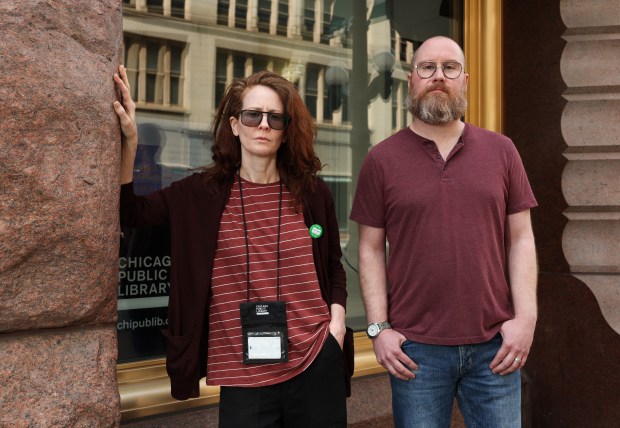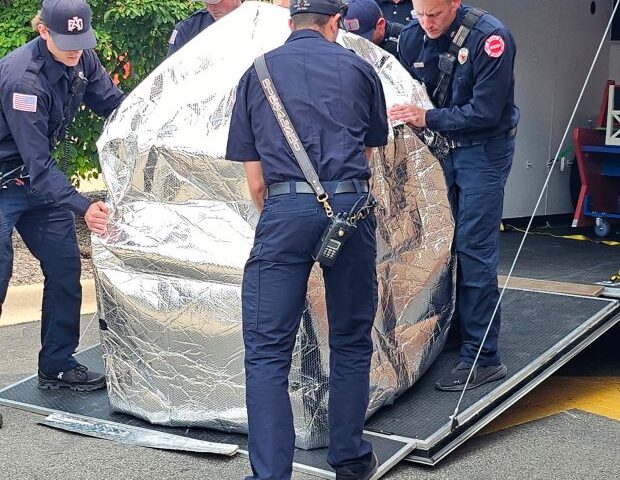On a good day, Christopher Crotwell said he will generally leave his job of 8 years at Harold Washington Library feeling sad. On a bad day, he will leave feeling angry.
Crotwell works in the computer commons on the third floor, where he said that violent and uncomfortable incidents are a regular occurrence for him at work.
A few weeks ago, Crotwell woke up a man sleeping at a computer. But what started with a tap on the table to get the man’s attention ended with the patron being escorted out by security, threatening him from the moment he woke up all the way until he was out of Crotwell’s sight.
“I generally don’t feel unsafe in the city. I’m a pretty confident and happy-go-lucky person. I don’t tend to view people that I’m sharing a space with with much suspicion,” Crotwell said. But after that, Crotwell bought mace to keep with him.
“I don’t like the way that feels. I don’t want to have that in my backpack. I don’t want to feel like it’s necessary,” he said.
Understaffing, inconsistency in how to enforce rules and insufficient de-escalation training are just some of the issues staff at Harold Washington contend they are facing, some of which staff say are part of broader issues in the Chicago Public Library system. As a result, some staff say they are taking on a heavier-than-usual mental load as they struggle to attend to the needs of their patrons while fulfilling their duties and making the library a welcoming space.
While employees the Tribune spoke with acknowledged that safety has always been a concern at Harold Washington and at Chicago Public Library more broadly, employees allege that the issue has only gotten worse in recent months. It’s unclear whether more homeless people are appearing at library facilities, even as some staff members say their presence is a factor.
Despite the violence, Crotwell said he feels for the man who threatened him. That man, and many others who come through the building in a day, are some of Chicago’s most vulnerable people. They need access to the resources the library provides, but providing the best service possible to patrons can be difficult with regular outbursts that make staff and patrons feel unsafe, Crotwell said.
In the first quarter of this year, according to CPL records obtained by the Tribune in a FOIA request, there were about 240 incident reports filed by staff. Those incidents range from hygiene concerns involving patrons to security officers not being present to verbal threats and physical assaults.
In that same time frame last year, documents showed only 10 such incident reports were filed, though CPL did not return any incident reports from March 2024.
A series of issues
“I no longer really use the elevators, and I try not to be in spaces where I can’t escape readily in the building, or that don’t have a lot of visibility,” said Adrienne Seely, who works at Harold Washington and serves as the vice president of the American Federation of State, County and Municipal Employees Local 1215 — the union that represents Chicago Public Library workers. “Even if I’m having a bad day, I kind of try to project friendliness because I don’t want to give anyone any kind of reason if (a patron is) on edge already to kind of find an excuse to lash out.”
On Feb. 13, a worker at Harold Washington was attacked by another patron while he was giving a tour, according to documents. He was escorted to urgent care following the incident.
In another instance on Feb. 28, a brawl broke out between patrons in the library and left at least one person with a stab wound. In another, filed on Feb. 11, one patron shattered a door window at the library.
On March 11, a male patron struck a female patron who was waiting with her child by the elevator.
“I don’t interact with the public more than I have to because I’ve asked innocuous questions or had seemingly benign conversations just suddenly go south,” said one Harold Washington librarian who asked not to be named out of fear of retribution. “I pretty much stay at the desk and if I have to go out and grab a book or something, I will, but I won’t just walk around.”
Other incident reports reviewed by the Tribune detail cases of patrons watching porn in the computer commons, indecently exposing themselves to others and damaging library property.
“CPL welcomes more than five million visitors each year, with the vast majority of visits occurring without incident,” a spokesperson for Chicago Public Library wrote in a statement to the Tribune. “Still, as public spaces, our libraries require ongoing vigilance to ensure the well-being of both patrons and staff.”
In response to safety concerns, Chicago Public Library formed a safety task force to work on short and long-term solutions to help make the library a safer place.
Some patrons who frequent Harold Washington have also expressed frustrations with the library, some of which were detailed in a survey sent out by Chicago Public Library on Feb. 26. Those survey results, sent out in collaboration with mental health service NAMI Chicago, were obtained by the Tribune in a FOIA request to Chicago Public Library. The Tribune completed its own analysis of the survey findings.
Some of the nearly 1,700 respondents offered general input on multiple facilities, making it difficult to tease out their experiences at each place. Focusing on respondents who only cited their experience at one facility, the Tribune looked at facilities with at least 30 responses and found the system’s main library — Harold Washington — had the highest rate of responders saying they disagreed that they felt safe when visiting the library, at about 13%. The second-highest rate was for the Bezazian Branch, with 5%, with the others hovering at or below 3%, with seven having no one report they felt unsafe.
Still, it’s unclear how well the survey represents how most patrons feel, with less than 200 responses for Harold Washington, a facility that sees thousands of visitors each month, according to the Chicago Data Portal.
“It is frustrating to pay taxes to support this place and see it being destroyed,” wrote one survey respondent who frequents Harold Washington and said they have been offered drugs at the branch.
Trouble across the US
Librarians across the country say they’re experiencing more violent incidents and a lack of resources to properly address those violent incidents, causing many librarians to burn out. In Sacramento, a librarian was shot and killed in her workplace’s parking lot by a man with whom she had a previous run-in. In Iowa, a library had to close for the day after receiving a bomb threat. In Boston, two men got into a fight in a library branch where one wielded an axe.
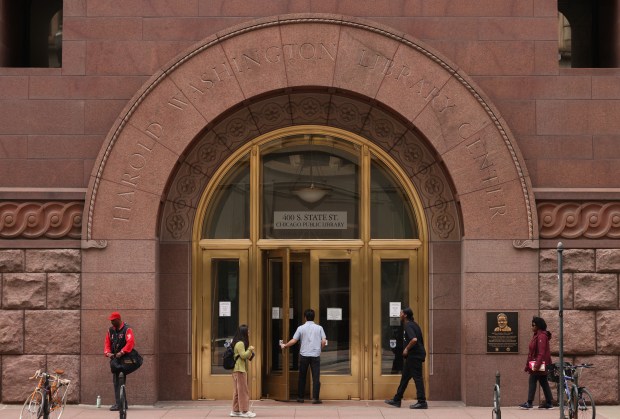
Karen Fisher, a professor at the University of Washington’s Information School has studied the rise of violent incidents in libraries across the country and the impact of those incidents on librarians’ mental health. In her study, Fisher found that one in five staff had experienced physical assault, and one in 20 had experienced life threatening injuries. Librarians of color, she found, were also frequently targeted with microaggressions or racist acts by patrons or other staff members. Verbal abuse was one of the most common experiences she found in her study, with female staffers twice as likely to experience verbal abuse.
Other major sources of stress on librarians include censorship and book bans as well as issues with employers.
“What’s been going on in Chicago is really consistent with what’s happening right across the country,” Fisher said. “They’ve had bomb threats, physical violence, and the biggest problems, of course, has to do with fentanyl. But all of these problems, I think it’s important for people to understand that this stuff is not isolated to just the big cities in the country. It’s happening everywhere.”
Staffing and de-escalation training
Fisher said that libraries have always been “the heartbeat of communities.” They are places for everyone to receive services such as access to free wifi and a place to charge electronics. But in recent years, librarians across the country have taken on an even stronger role as frontline workers.
“What we have noticed is that there’s even more people coming to public libraries than ever before, and there is more trauma happening in public libraries,” Fisher said. “So we’ve always had situations of having to support patrons with the problems they might be experiencing, but this is now more profound than ever.”
It is a role that many have expressed feeling underprepared for, including within CPL. While the Chicago Public Library system told the Tribune it requires all of its staff to complete “five hours of de-escalation training grounded in trauma-informed care,” along with providing some optional mental health and crisis training sessions, some staff still feel like more training is needed.
Last year, all CPL staff had de-escalation training which included info on trauma-informed service, according to the union. That training consisted of watching several hours worth of videos on best practices and while opinions on the de-escalation training were mixed, a common sentiment Seely heard was that staff felt that it would have been more effective to have an in-person training with roleplay scenarios.
“We are understaffed. We have to get through webinars as quickly as we can,” Seely said. “And having that kind of ability to think back to something you watched on the screen – and while maybe also doing two other aspects of your job while you’re watching it – it’s just not as effective as it could be.”
Understaffing is an issue that the union said is an issue both within Harold Washington Library and the Chicago Public Library system as a whole, according to Anders Lindall, spokesperson for the American Federation of State, County and Municipal Employees Council 31, which represents Chicago Public Library workers.
In Jan. of 2020, before the pandemic, CPL had a total of 1,242 staff members, according to Lindall. Before then, Chicago’s Inspector General released in a May 2018 audit report that Chicago Public Library’s staffing levels were insufficient.
Chicago Public Library, however, said that their staffing levels are at the highest they’ve been since 2011.
As of Mar. 19 2025, according to the Chicago Public Library website, there are about 1,153 people who work for Chicago Public Library, just 796 of whom are full-time. Lindall also noted that this year’s budget cuts 50 staff positions.
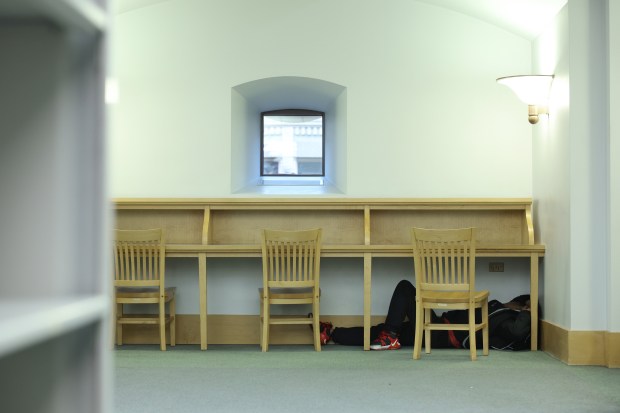
Some CPL branches also provide social services for its most vulnerable patrons. At Harold Washington Library, this includes a collection of social service agencies known as CPL Cares. Octavion Thomas, who oversees the Chicago Loop Alliance’s efforts at the library, said that his organization has been offering a linkage service out of the seventh floor of Harold Washington for about five years.
While Thomas has never personally had any experiences at the library where he felt unsafe, he did recognize an increasing role of librarians in dealing with people who may be suffering with mental health or other issues. He frequently talks to the library staff and said that not only are they appreciative of the social services at Harold Washington, but also that they frequently ask Thomas questions about how to handle certain situations with patrons.
“I’m getting a sense of what they see, because it’s based on the questions that they may ask and they want to be able to connect with people,” Thomas said. “They want to be able to have something to give them, something tangible to get them, among other things, or even just what to say to people that they run across.”
Seely echoed a similar sentiment, emphasizing that the profession often draws on an “empathetic workforce.”
“It’s difficult sometimes to know, for example, that if you call the police then someone may get cycled through the justice system and come out more traumatized on the other end than they were when they went in and then coming back to the library, presenting more problems than they had before,” Seely said.
Adjudicating suspensions
Beyond staffing levels, librarians have also expressed frustration with how suspensions are implemented at the library. While only a small number of patrons, according to Crotwell, are the ones causing issues in the library, how long to suspend a patron for can be difficult to assess. With the exception of more extreme situations, such as if a patron is expected to appear in court for a specific incident, Crotwell said the longest a person is usually suspended is a month.
“It feels a lot of the time like, essentially, patrons could do whatever they would like up to 12 times a year,” Crotwell said. “And the only reason the number is 12 is because you run out of months that can be escalated, like it can go through a process of judicial review, but how and when the administration does that is just not clear.”
In one incident report reviewed by the Tribune, a patron who appeared to be inebriated or on drugs was allegedly throwing library chairs and books on the fourth floor. When staff members found him, he was agitated and swearing and had allegedly ripped a sign from a column. When a staff member approached him, he cursed at her and lunged towards her. He was given a suspension of two weeks.
In another, a patron threatened to hurt a staff member after he was told he was not allowed to sit at a desk and roll a blunt in the computer commons. He was issued a seven-day suspension.
In another case, a patron was touching himself inappropriately and approaching a staff member shelving books. While the incident report said the staff member was told to file a police report, it appears that the patron was given a 30-day suspension. In another report, a man who was seen by a security guard masturbating in the library was initially recommended a seven day suspension, but then was suspended indefinitely pending a court decision.
“There are patrons that have groped my co-workers. There are patrons that have masturbated at our computers,” Crotwell said. “You know, 30 days they come right back in. What behavior rises to the level of letting someone know that they’re a danger to the space and that they can’t return is just unclear.”
One librarian the Tribune spoke with who asked not be named for this story for fear of retribution described the suspension pattern as a spiral, where people with offenses can often easily come back after their suspension ends.
“If it was me that was in charge, they’d be banned for life,” she said. “People shouldn’t have to be subjected to that.”
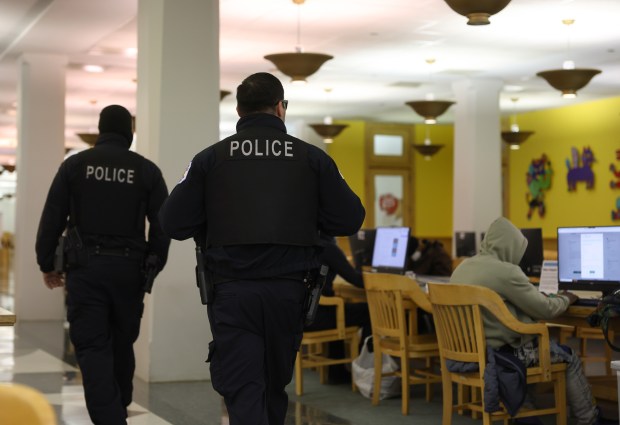
Chicago Public Library representatives wrote to the Tribune that they use a systemwide library suspension matrix to address serious behavioral violations, which includes review by management of all suspension-related incident reports to ensure fairness and consistency. The tool is reviewed regularly to meet evolving needs and staff are encouraged to consult supervisors if they are unsure of what kind of suspension to give, according to CPL.
But according to Seely, there have been disagreements between staff and management about how long certain patrons should be suspended for.
“[We] need more concrete guidance so that we don’t get in situations where we’re disagreeing with management, potentially about how to adjudicate that,” Seely said. “We all know that we are a public institution and we take that responsibility seriously, that we have to provide public access, except when there’s serious causes for denying it … it’s a tricky balance, and it’s definitely a source of stress for staff to try to judge that.”
Solutions
While librarians the Tribune spoke with recognized that some of the safety concerns are part of larger societal problems that fall outside of the library’s jurisdiction, staff still felt that changes could be made to make the library a safer place.
“There’s always a push and pull with CPL leadership in terms of staff asking for things that we think would be effective in making our library more safe and the perception of being unwelcoming,” Seely said.
At one point, Harold Washington Library had book-theft detection gates. While these gates were phased out in 2019 due to the elimination of overdue fines, staff felt that they had a deterrent effect and miss that deterrent effect, according to Seely.
Chicago Public Library representatives wrote in their email to the Tribune that based on staff feedback and Safety Task Force recommendations, there are initiatives for the summer 2025 and beyond that will include training on incident reporting, emergency response and advanced conflict prevention techniques. The agency also wrote that it has met with staff on every floor of Harold Washington to gain input on how to make the library safer and has increased security coordination to make the library an overall safer place.
Lawmakers in Illinois also appear to have taken notice of the situation playing out in libraries across the country. Last year, a bill introduced to the Illinois state government allowed for increased protections towards library employees, but the bill never became law.
Seely also felt that ever since Chicago Public Library started working with mental health consultant NAMI Chicago, staff have been more assertive in issuing harsher suspensions for patrons who are verbally abusive towards them. That increased sense of agency, Seely said, is a step in the right direction, but staff say more is still needed. Ideally, Seely said that staff would like to see a social worker present at the library every hour they are open since librarians are typically not trained in that field.
“People want great public services from their libraries, but they want their library workers to be library workers,” Lindall said. “And if that means we need to advocate for more staff in order to have those great public services, let’s do it. If it means we need to have a little bit more security in order to be safe, let’s do it. If it means that we need to say, ‘If you commit a sexual offense in a library, that’s a one strike and you’re out situation.’”


